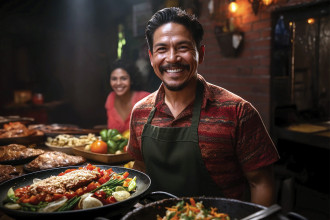
Text by Sajeet M. Rajbhandari
With over 170 years of cultural history, tea has certainly embedded itself to become a part of the Nepali lifestyle. From being an early morning beverage to start the day to an excuse for old acquaintances to sit down and chat, tea has become phenomenal socio-cultural glue. While it might seem trivial at first glance, the way Nepal interacts with tea has led it to become one of Nepal’s most promising exports and is an industry worth billions of rupees. If given the correct attention and nurture, tea is capable of becoming so much more than a mere beverage.
Deepak Khanal, the acting Executive Director for the Nepal Tea and Coffee Development Board shares that the first recorded coming of tea into Nepal was when Jung Bahadur Rana brought back some tea plants as a gift from his visit to China. These plants were then taken to the district of Ilam and has now turned into one of Nepal’s biggest tea plantations. “Even the tea that we consume today on a daily basis is the same species as the ones that were brought from China.” shares Khanal. He goes on to add, “The Ilam tea gardens that we all know and hear about led to the development of more tea gardens at different places. Not limiting itself to just one geographic location, the process of tea cultivation has reached five other districts in the East: Ilam, Panchthar, Jhapa, Dhankuta and Tehrathum. Today tea plantation has reached 18 districts commercially.” However, Khanal also mentions that the original Eastern districts continue to maintain top spot in terms of production and market share, with Jhapa leading the table producing 18.8 million kilograms in the 2016/2017 fiscal year alone and Ilam following at second place with 4.9 million kilograms.
“We export tea in two primary ways. One is that we export directly to India and the other is that we send our product through India to other nations.”
Deepak Khanal
Acting Executive Director for the Nepal Tea and Coffee Development Board
This significant difference in production numbers can be linked with the types of tea that are grown in the region. According to Khanal, “There are two basic categories of tea that is grown in Nepal. One of which is produced in only one district out of all 77 districts in Nepal, and that is Jhapa. This tea is what we call CTC (Crush, Tear, Curl) tea and is consumed by a large number of people on a daily basis.” He adds, “The other type of tea is known as orthodox tea which is usually grown in hillier geographic regions. From orthodox tea stems out a number of other variations, with the likes of green tea, oolong tea, black tea, white tea and so many more.”
When asked why CTC tea is only commercially grown in Jhapa, Khanal states that a study regarding this is still due. Nevertheless, he mentions, “Close to the geographic area of Jhapa’s famous Himalayan Tea Garden is Morang’s Urlabari situated right across Mawa river; here we don’t see a single tea plantation. It is not that the people don’t want to grow tea but the soil seems to be unyielding when it comes to CTC tea.”
While the annual amount of production is much greater for CTC, it is actually orthodox tea that is seen to have much more economic value. Khanal claims that only approximately 5 million kilograms worth of orthodox is generated annually, it is also the most sought after for export. Jagannath Nepal, owner of Himalayan Garden Tea Shop, one of Thamel’s oldest tea shops, agrees with Khanal when it comes to the matter of value that orthodox tea carries. “CTC tea tends to grow in larger quantities unlike orthodox tea. Orthodox tea tends to be much finer with smaller leaves and carries a more distinct taste profile.” explains Nepal, “Orthodox tea is more of a boutique purchase while CTC tea is something that is processed and easily mass produced.” However, this also means that orthodox tea has a really small demand in the local market unlike most domestic commercial tea brands. “Usually the people who buy orthodox tea are foreigners.” says Nepal, “They usually buy 100 grams or so of tea at a time as souvenirs, with the exception of Chinese tourists that tend to purchase in bulk. Aside from a few enthusiasts, there are hardly any local Nepali buyers.”
This doesn’t seem to be the case for Rakura, a tea brand from one of Nepal’s largest commercial tea manufacturers and exporters. Ravi Rathi, the Executive Director of Rakura states that for them commercialising and mass producing orthodox green and black tea has been an excellent move. “We are surprised by how well our green tea has taken off,” states Rathi who initially planned for Rakura to be a more niche product but is now finding it in local ‘kirana pasals’ around the country. “The demand is just going up every year. In fact, the green tea market in Nepal - at least for us - is growing over a 100% year on year,” claims Rathi.
The sale of orthodox tea is also very dependent on the season of harvest. The tea harvest in Nepal are in fact generally classified into four different flushes: spring, summer, monsoon and autumn. The spring flush is considered the best of all four harvests. 100 grams of SFTGFOP-1 (Super Fine Tippy Golden Flowery Orange Pekoe - Grade 1) - the finest rank for teas - from the spring flush in Ilam and costs somewhere around Rs. 1200.
So how do such fine teas travel all the way from a tea garden in Ilam to a cup of brew in our homes? Well according to Rathi, the process that tea goes through to become what we drink everyday is a very vivid and skillful journey. “For Rakura, we run four different factories. Two of which are orthodox, one for CTC and a factory for packaging.” shares Rathi who also states that their final product is sourced from their own factories and some select high grade tea factories. Rathi further explains, “The first process that we go through while manufacturing tea is tasting. We bring samples from different gardens for tasting. Once the tea has been selected, the produce from Ilam or Jhapa is brought to our warehouse in Biratnagar where it is placed in a state-of-the-art climate-controlled facility. The produce then goes through a processing facility after which it is sent through a machine that makes them into tea-bags. Those tea-bags are then finally packaged.” These packaged products then don’t just reach the local shops and supermarkets but also travel across the globe to foreign consumers.
“The demand is just going up every year. In fact, the green tea market in Nepal - at least for us - is growing over a 100% year on year.”
Ravi Rathi
Executive Director of Rakura Tea
As a matter of fact, coffee, tea and spices contributed to Rs. 6.4 billion in export in the fiscal year 2017/2018 and is one of the nation’s most promising exports. “We export tea in two primary ways,” shares Khanal, “One is that we export directly to India and the other is that we send our product through India to other nations.”
Rathi is confident about the tea industry in Nepal and claims, “This (tea) will be Nepal’s largest export in the future. In terms of value, Nepali tea is one of the best in the world.” As a matter of fact, Nepal exported over 15 metric tons of tea in the fiscal year 2017/18 alone which was commercially worth well over Rs 3 billion.
“CTC tea tends to grow in larger quantities unlike orthodox tea. Orthodox tea tends to be much finer with smaller leaves and carries a more distinct taste profile.”
Jagannath Nepal
owner of Himalayan Garden Tea Shop
However, it is not that the tea industry is working without any problem. “Over the years we have seen that Nepali tea was either blended into finer tea without the mention of its origin, or was sold singularly as high-end Indian or Chinese tea,” admits Rathi. Khanal also agrees with this situation, saying, “Many businesses often complain to us that the tea produced in the Eastern region of Nepal is many-a-times bought in bulk by Indian manufacturers, after which it is taken to Darjeeling and packed, labeled and sold off as Darjeeling tea.” The tea from these two regions are often said to have a similar taste profile. But while Darjeeling tea has made a name for itself worldwide, the quality of Nepali tea is still unknown to a large part of the world. Furthermore, when compared with competing nations, the Nepali tea industry hasn’t even been able to scratch the surface. According to Rathi, “Today we are exporting about $30 million worth of tea; Sri Lanka exports $1.3 billion dollars. We produce better tea than they do yet we’re doing so much less in export.” And while we did earn Rs 3 billion from exporting tea in 2017/2018, it is also important to take into account that Nepal also imported Rs.120.9 million worth of tea in the same year.
While the tea industry in Nepal has come a long way since it first started, the industry still has a long way to go. Blessed with ideal geographic conditions, Nepal is a haven when it comes to commercially producing high grade tea and is well capable of becoming a top-ranking export commodity. But authorities, producers and consumers, all need to pull up their sleeves and contribute in uplifting the status of the excellence of the Nepali chhiya.


-1765706286.jpg)
-1765699753.jpg)

